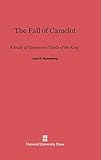The Fall of Camelot : A Study of Tennyson's ‹i›Idylls of the King‹/i› / John D. Rosenberg.
Material type: TextPublisher: Cambridge, MA : Harvard University Press, [2013]Copyright date: ©1973Edition: Reprint 2014Description: 1 online resource (182 p.)Content type:
TextPublisher: Cambridge, MA : Harvard University Press, [2013]Copyright date: ©1973Edition: Reprint 2014Description: 1 online resource (182 p.)Content type: - 9780674422933
- 9780674422957
- Arthurian romances -- History and criticism
- Camelot (Legendary place)
- Englische Literatur
- Kings and rulers in literature
- Knights and knighthood in literature
- Medievalism -- England -- History -- 19th century
- Medievalism
- Middle Ages in literature
- LITERARY CRITICISM / General
- Tennyson, Alfred Tennyson, Baron, 1809-1892. Idylls of the King
- LITERARY CRITICISM / General
- 821/.8
- PR5560 .R6
- online - DeGruyter
| Item type | Current library | Call number | URL | Status | Notes | Barcode | |
|---|---|---|---|---|---|---|---|
 eBook
eBook
|
Biblioteca "Angelicum" Pont. Univ. S.Tommaso d'Aquino Nuvola online | online - DeGruyter (Browse shelf(Opens below)) | Online access | Not for loan (Accesso limitato) | Accesso per gli utenti autorizzati / Access for authorized users | (dgr)9780674422957 |
Browsing Biblioteca "Angelicum" Pont. Univ. S.Tommaso d'Aquino shelves, Shelving location: Nuvola online Close shelf browser (Hides shelf browser)

|

|

|

|

|

|

|
||
| online - DeGruyter The Seventh Hero : Thomas Carlyle and the Theory of Radical Activism / | online - DeGruyter American Appeasement : United States Foreign Policy and Germany, 1933-1938 / | online - DeGruyter John Ruskin, or the Ambiguities of Abundance : A Study in Social and Economic Criticism / | online - DeGruyter The Fall of Camelot : A Study of Tennyson's ‹i›Idylls of the King‹/i› / | online - DeGruyter William Lawrence : Later Years of a Happy Life / | online - DeGruyter Carlyle and the Burden of History / | online - DeGruyter Shakespeare and the Craft of Tragedy / |
Frontmatter -- Acknowledgments -- Contents -- Note on Citations -- I. Dispelling the Mists -- II. Evolving the Form -- III. Timescape -- IV. Landscape -- V. Character and Symbol -- VI. Symbol and Story -- Notes. Bibliography. Index
restricted access online access with authorization star
http://purl.org/coar/access_right/c_16ec
The Idylls of the King is one of the indisputably great long poems in the English language. Yet Tennyson's doom-laden prophecy of the fall of the West has been dismissed as a Victorian-Gothic fairy tale. John D. Rosenberg maintains that no poem of comparable magnitude has been so misread or so maligned in the twentieth century as Tennyson's symbolist masterpiece. In The Fall of Camelot the author calls into question the modernist orthodoxy that rejects all of Victorian poetry as a Waste Land and ignores the overriding importance of Tennyson to the development of Yeats, T. S. Eliot, and the symbolists. Far from being an escapist medieval charade, the Idylls offers an apocalyptic prevision of the nightmare of modern history. Concealed under the exquisitely romantic surface of the verse is a world of obsessive sensuality and collapsing values that culminates in the "last dim weird battle the West." Perhaps the subtlest anatomy of the failure of ideality in our literature, the Idylls is not only about hazards of mistaking illusion for reality; it dramatically enacts those dangers, ensnaring the reader in the same delusions that maim and destroy the characters. Rosenberg shows that Tennyson has created a new genre whose true originality criticism has yet to perceive. By employing landscape as a symbolic extension of character, Tennyson obliterates the gap between self and scene and frees himself from bondage to conventional narration. Throughout the Idylls character cannot be extricated from setting or symbol, and neither has substance apart from the narrative in which it is enmeshed. In essence, the narrative is a sequence of symbols protracted in time, the symbolism a kind of condensed narration. "Timescape" in the Idylls, like landscape, serves to bind all events of the poem into a continuous present. Arthur is at once a Christ figure and Sun-King whose career parallels that of his kingdom, waxing and waning with the annual cycle. At the heart of Arthur's story lies the dual cycle of his passing and promised return. Incorporating this cycle into its structure, the Idylls is itself a kind of literary second coming of Arthur, a resurrection in Victorian England of the long sequence of Arthuriads extending back before Malory and forward through Spenser, Dryden, Scott, and Tennyson.
Mode of access: Internet via World Wide Web.
In English.
Description based on online resource; title from PDF title page (publisher's Web site, viewed 24. Aug 2021)


